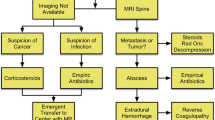Abstract
Acute spinal cord compression (SCC) is the most serious of the diseases of the cord and should be accorded special attention in neurocritical care. Patients with SCC have a combination of motor and sensory dysfunction that has a distribution referable to one, or a few contiguous, spinal levels. Bowel and bladder dysfunction and neck or back pain are usually part of the clinical presentation but are not uniformly present. Because interventions are time-sensitive, the recognition and treatment of SCC was chosen as an ENLS protocol.

Similar content being viewed by others
References
Wuermser LA, Ho CH, Chiodo AE, Priebe MM, Kirshblum SC, Scelza WM. Spinal cord injury medicine. 2. Acute care management of traumatic and nontraumatic injury. Arch Phys Med Rehabil. 2007;88:S55–61.
Schmidt RD, Markovchick V. Nontraumatic spinal cord compression. J Emerg Med. 1992;10:189–99.
Bammer R, Fazekas F. Diffusion imaging of the human spinal cord and the vertebral column. Top Magn Reson Imaging. 2003;14:461–76.
Husband DJ. Malignant spinal cord compression: prospective study of delays in referral and treatment. BMJ. 1998;317:18–21.
Klimo P Jr, Thompson CJ, Kestle JR, Schmidt MH. A meta-analysis of surgery versus conventional radiotherapy for the treatment of metastatic spinal epidural disease. Neuro Oncol. 2005;7:64–76.
Gilbert RW, Kim JH, Posner JB. Epidural spinal cord compression from metastatic tumor: diagnosis and treatment. Ann Neurol. 1978;3:40–51.
Bach F, Larsen BH, Rohde K, et al. Metastatic spinal cord compression. Occurrence, symptoms, clinical presentations and prognosis in 398 patients with spinal cord compression. Acta Neurochir (Wien). 1990;107:37–43.
Schiff D, O’Neill BP. Intramedullary spinal cord metastases: clinical features and treatment outcome. Neurology. 1996;47:906–12.
Mut M, Schiff D, Shaffrey ME. Metastasis to nervous system: spinal epidural and intramedullary metastases. J Neurooncol. 2005;75:43–56.
Sundaresan N, Sachdev VP, Holland JF, et al. Surgical treatment of spinal cord compression from epidural metastasis. J Clin Oncol. 1995;13:2330–5.
Burch PA, Grossman SA. Treatment of epidural cord compressions from Hodgkin’s disease with chemotherapy. A report of two cases and a review of the literature. Am J Med. 1988;84:555–8.
Boogerd W, van der Sande JJ, Kroger R, Bruning PF, Somers R. Effective systemic therapy for spinal epidural metastases from breast carcinoma. Eur J Cancer Clin Oncol. 1989;25:149–53.
Chen YJ, Chang GC, Chen HT, et al. Surgical results of metastatic spinal cord compression secondary to non-small cell lung cancer. Spine (Phila Pa 1976). 2007;32:E413–8.
Patchell RA, Tibbs PA, Regine WF, et al. Direct decompressive surgical resection in the treatment of spinal cord compression caused by metastatic cancer: a randomised trial. Lancet. 2005;366:643–8.
Mannion RJ, Wilby M, Godward S, Lyratzopoulos G, Laing RJ. The surgical management of metastatic spinal disease: prospective assessment and long-term follow-up. Br J Neurosurg. 2007;21:593–8.
Walji N, Chan AK, Peake DR. Common acute oncological emergencies: diagnosis, investigation and management. Postgrad Med J. 2008;84:418–27.
Delattre JY, Arbit E, Rosenblum MK, et al. High dose versus low dose dexamethasone in experimental epidural spinal cord compression. Neurosurgery. 1988;22:1005–7.
Sorensen S, Helweg-Larsen S, Mouridsen H, Hansen HH. Effect of high-dose dexamethasone in carcinomatous metastatic spinal cord compression treated with radiotherapy: a randomised trial. Eur J Cancer. 1994;30A:22–7.
Loblaw DA, Perry J, Chambers A, Laperriere NJ. Systematic review of the diagnosis and management of malignant extradural spinal cord compression: the cancer care ontario practice guidelines initiative’s neuro-oncology disease site group. J Clin Oncol. 2005;23:2028–37.
Rodesch G, Hurth M, Alvarez H, Tadie M, Lasjaunias P. Spinal cord intradural arteriovenous fistulae: anatomic, clinical, and therapeutic considerations in a series of 32 consecutive patients seen between 1981 and 2000 with emphasis on endovascular therapy. Neurosurgery. 2005;57:973–83; discussion 83.
Allen JC, Miller DC, Budzilovich GN, Epstein FJ. Brain and spinal cord hemorrhage in long-term survivors of malignant pediatric brain tumors: a possible late effect of therapy. Neurology. 1991;41:148–50.
Suzuki T, Abe E, Murai H, Kobayashi T. Nontraumatic acute complete paraplegia resulting from cervical disc herniation: a case report. Spine. 2003;28:E125–8.
Bracken MB, Holford TR. Effects of timing of methylprednisolone or naloxone administration on recovery of segmental and long-tract neurological function in NASCIS 2. J Neurosurg. 1993;79:500–7.
Mehta SH, Shih R. Cervical epidural abscess associated with massively elevated erythrocyte sedimentation rate. J Emerg Med. 2004;26:107–9.
Joshi SM, Hatfield RH, Martin J, Taylor W. Spinal epidural abscess: a diagnostic challenge. Br J Neurosurg. 2003;17:160–3.
Pradilla G, Ardila GP, Hsu W, Rigamonti D. Epidural abscesses of the CNS. Lancet Neurol. 2009;8:292–300.
Author information
Authors and Affiliations
Corresponding author
Rights and permissions
About this article
Cite this article
O’Phelan, K.H., Bunney, E.B., Weingart, S.D. et al. Emergency Neurological Life Support: Spinal Cord Compression (SCC). Neurocrit Care 17 (Suppl 1), 96–101 (2012). https://doi.org/10.1007/s12028-012-9756-3
Published:
Issue Date:
DOI: https://doi.org/10.1007/s12028-012-9756-3




